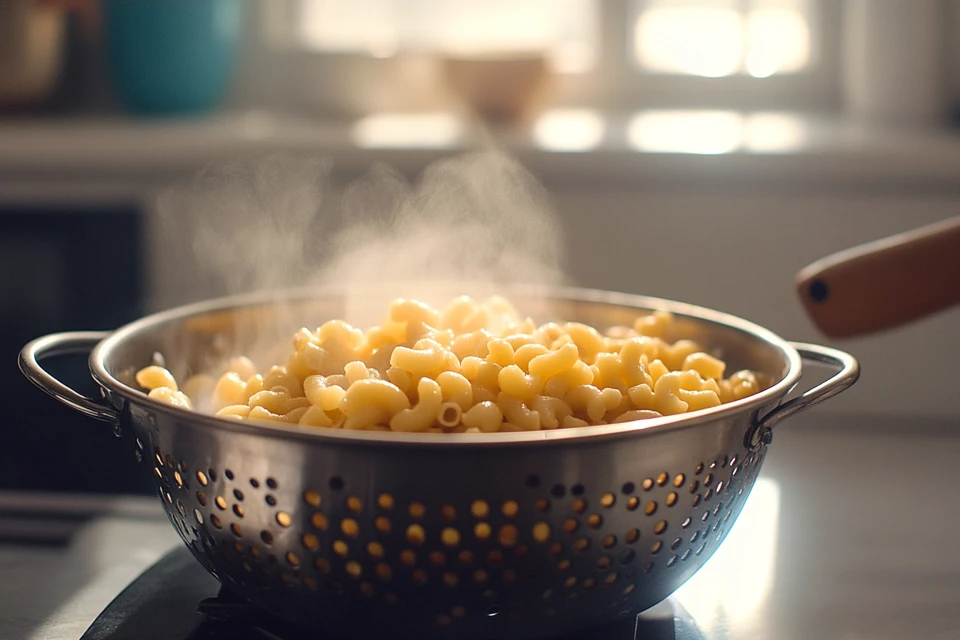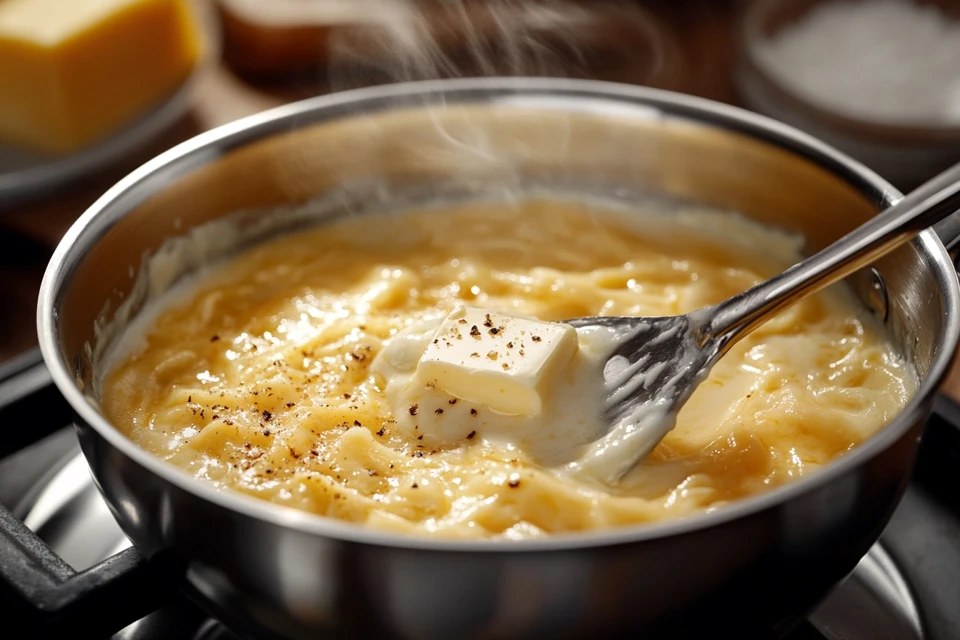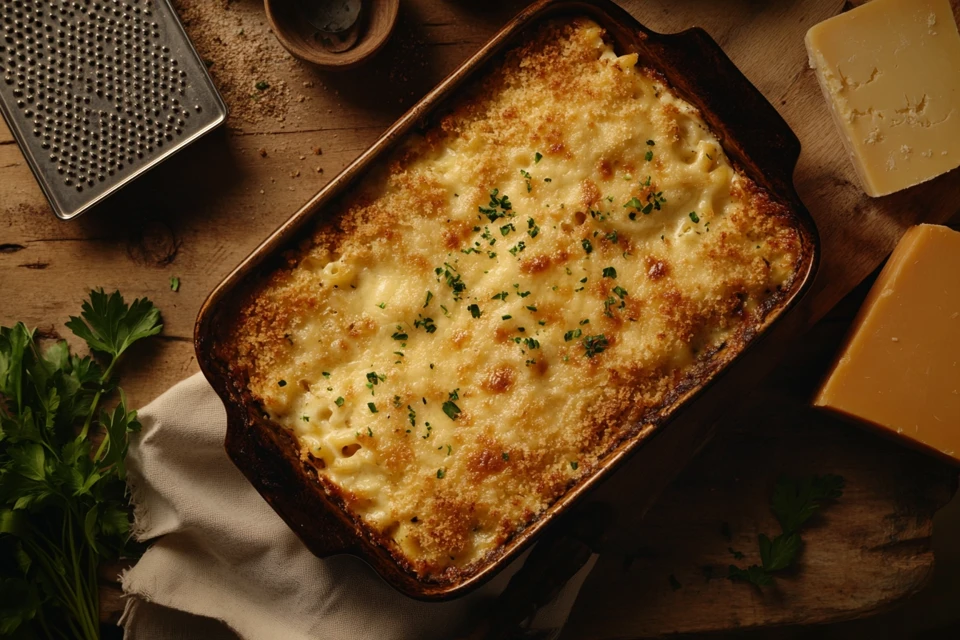1. Introduction
Mac and cheese is a cherished comfort food, enjoyed by people of all ages for its creamy, cheesy goodness. However, making the perfect mac and cheese isn’t always as simple as it seems. There are plenty of ways to go wrong, from overcooking the pasta to choosing the wrong cheese, and these missteps can leave you with a disappointing dish.
So, what not to do when making mac and cheese? This article uncovers the most common mistakes, offering expert advice and practical tips to ensure your mac and cheese turns out perfect every time. Whether you’re making it for a cozy dinner or a festive gathering, understanding these pitfalls will elevate your mac and cheese game to the next level.
2. Common Mistakes in Cooking Macaroni for Mac and Cheese
The foundation of any great mac and cheese is perfectly cooked pasta. Yet, this crucial step is often where things go wrong. Avoiding these common mistakes can ensure your macaroni is the perfect base for your creamy, cheesy sauce.
2.1 Overcooking the Pasta

Overcooked pasta is one of the most frequent errors when making mac and cheese. When pasta is boiled too long:
- It Becomes Mushy: Overcooked pasta absorbs more liquid, causing it to lose its firmness and become mushy when mixed with the sauce.
- It Loses Structure: The pasta may break apart when stirred, leaving you with a clumpy dish.
How to Avoid This:
- Cook your pasta al dente (firm to the bite). Refer to the package instructions, but start checking the texture a minute or two before the recommended cooking time ends.
- Remember that the pasta will continue cooking slightly when combined with the sauce or baked.
2.2 Using the Wrong Pasta Shape
Not all pasta shapes are created equal, especially for mac and cheese. Using the wrong shape can impact the texture and how well the sauce adheres to the pasta.
- Small or Smooth Pasta: Shapes like spaghetti or angel hair don’t hold sauce well, leaving your dish unevenly coated.
- Larger Hollow Shapes: While excellent for chunky sauces, shapes like rigatoni might overpower a creamy cheese sauce.
Best Pasta for Mac and Cheese:
- Elbow macaroni (the classic choice).
- Cavatappi or rotini (great for holding onto the sauce with their ridges and spirals).
- Shells (perfect for trapping cheesy goodness inside).
2.3 Rinsing Cooked Pasta
Rinsing pasta is another mistake that can ruin your mac and cheese. Here’s why:
- It Washes Away Starch: Starch helps the sauce cling to the pasta, creating a cohesive dish.
- It Lowers the Temperature: Rinsing with cold water can cool the pasta, making it harder for the cheese sauce to coat evenly.
When Rinsing May Be Necessary:
- If you’re making a pasta salad or preparing pasta ahead of time for a cold dish.
For mac and cheese, avoid rinsing your pasta to maintain its starchy surface, ensuring a creamy, well-coated dish.
3. Cheese-Related Mistakes to Avoid
The cheese is the heart of any mac and cheese recipe, and using the wrong type—or handling it incorrectly—can lead to disappointing results. Let’s explore what not to do when making mac and cheese when it comes to choosing and incorporating cheese.
3.1 Using Only One Type of Cheese
One of the biggest mistakes in mac and cheese is relying on a single type of cheese. While cheddar is a classic choice, using only one cheese can result in a dish that’s one-dimensional in flavor and texture.
Why Cheese Blends Work Best:
- Balance of Flavors: Sharp cheddar offers tanginess, gouda adds creaminess, and mozzarella provides stretchiness.
- Improved Texture: Combining different cheeses helps prevent the sauce from becoming gritty or overly dense.
What to Do Instead:
- Use a mix of at least two or three cheeses. For example, sharp cheddar, Monterey Jack, and a touch of parmesan create a rich and well-rounded flavor profile.
Check out Tini’s Mac and Cheese Recipe for more inspiration.
3.2 Choosing the Wrong Cheese
Not all cheeses are suitable for melting. Some cheeses, like feta or goat cheese, don’t melt smoothly, resulting in a lumpy or greasy sauce.
Cheeses to Avoid:
- Crumbly cheeses like blue cheese or feta.
- Hard cheeses like pecorino romano (unless used in small amounts for flavor).
Cheeses That Work Well:
- Medium to sharp cheddar.
- Fontina, gouda, or havarti for creaminess.
- Mozzarella or provolone for stretchiness.
- A small amount of processed cheese, like Velveeta, to stabilize the sauce.
3.3 Adding Cheese Incorrectly
Even if you use the right cheese, how you add it matters. Adding cheese too quickly or at the wrong temperature can cause the sauce to break, resulting in a greasy or gritty texture.
What Not to Do:
- Adding cheese over high heat, which can cause it to separate.
- Dumping all the cheese in at once, leading to clumps.
Best Practices:
- Lower the heat before adding cheese.
- Add the cheese gradually, stirring constantly to ensure a smooth and even melt.
Taking these steps ensures your cheese sauce is creamy, cohesive, and perfectly melted.
4. Sauce Preparation Errors: What Not to Do When Making Mac and Cheese
The cheese sauce is the defining feature of mac and cheese, and mistakes during its preparation can ruin the dish. Knowing what not to do when making mac and cheese will help you craft a smooth, creamy sauce every time.
4.1 Skipping the Roux: What Not to Do When Preparing Mac and Cheese Sauce

A roux—a mixture of butter and flour—is the base of most mac and cheese sauces. Skipping this step or making a poor roux leads to a thin, watery sauce that lacks stability.
Why Roux is Essential:
- It thickens the sauce, ensuring it coats the pasta properly.
- It stabilizes the cheese, preventing separation or greasiness.
What Not to Do:
- Using too much flour, which can make the sauce taste grainy.
- Cooking the roux for too short a time, leaving a raw flour flavor.
What to Do Instead:
- Cook the roux until it turns golden and has a nutty aroma.
- Whisk constantly to avoid clumps.
4.2 Using the Wrong Type of Milk or Cream
The type of dairy you choose directly impacts the creaminess of your sauce. Using low-fat or skim milk is one of the most common errors in mac and cheese.
What Not to Do:
- Using low-fat milk, which results in a thin, less creamy sauce.
- Substituting water or non-dairy milk without adjustments.
What Works Best:
- Whole milk provides the perfect balance of richness and creaminess.
- Heavy cream or a combination of milk and cream enhances the sauce’s texture.
- For a baked version, evaporated milk works well to prevent drying.
Learn how ingredient choices affect texture in other dishes like cobblers by visiting What Happens If You Don’t Peel Peaches for Cobbler?.
4.3 Rushing the Béchamel Sauce
Béchamel, a white sauce made with roux and milk, is a critical step in many mac and cheese recipes. Rushing this process is a major mistake.
What Not to Do:
- Adding milk too quickly, which can create lumps.
- Cooking over high heat, which risks scorching the milk.
How to Avoid This:
- Gradually pour in milk while whisking constantly for a smooth consistency.
- Cook the béchamel over medium heat, allowing the flavors to develop fully.
Taking the time to master these techniques ensures your mac and cheese sauce is rich, creamy, and free of any unwanted lumps or separation.
5. Baking Mistakes That Ruin Mac and Cheese: What Not to Do
Baking mac and cheese can elevate it to a golden, bubbly masterpiece, but it’s also where many people go wrong. Knowing what not to do when making mac and cheese in the oven will help you maintain its creamy texture and delicious flavor.
5.1 Not Mixing the Sauce Thoroughly Before Baking
One of the biggest mistakes when baking mac and cheese is failing to coat the pasta evenly with sauce. This can leave parts of the dish dry or under-flavored.
What Not to Do:
- Pouring the cheese sauce over the pasta and assuming it will mix itself while baking.
- Leaving some pasta exposed, which causes it to dry out in the oven.
What to Do Instead:
- Mix the cooked pasta and cheese sauce thoroughly in a large bowl before transferring it to the baking dish.
- Stir again after transferring to ensure every bite is coated.
5.2 Overbaking the Mac and Cheese

Baking adds texture and a crispy topping, but overbaking can dry out the cheese sauce and toughen the pasta.
What Not to Do:
- Leaving the dish in the oven for too long.
- Using an oven temperature that’s too high, which can evaporate the sauce.
How to Avoid This:
- Bake at a moderate temperature, around 350°F (175°C).
- Cover the dish with foil for the first 20 minutes of baking to retain moisture. Remove the foil toward the end to achieve a golden crust.
5.3 Using Too Much or the Wrong Kind of Topping
Toppings like breadcrumbs or extra cheese can enhance baked mac and cheese, but overdoing it can cause issues.
What Not to Do:
- Adding a thick layer of breadcrumbs that absorbs too much moisture.
- Using dry or untoasted breadcrumbs, which may not crisp up.
What to Do Instead:
- Toss breadcrumbs in melted butter before sprinkling them on top for a golden, crispy finish.
- Use shredded cheese beneath the breadcrumbs to lock in moisture and flavor.
By avoiding these baking mistakes, you can achieve a mac and cheese that’s creamy inside and perfectly crisp on top.
6. Seasoning and Flavoring Errors: What Not to Do When Making Mac and Cheese
Seasoning plays a crucial role in enhancing the flavors of mac and cheese. Neglecting this step—or going overboard—can lead to a bland or overly complex dish. To perfect this comfort food, let’s explore what not to do when making mac and cheese when it comes to seasoning.
6.1 Underseasoning the Sauce
One of the most common mistakes in mac and cheese is relying solely on cheese for flavor. While cheese contributes richness, it often needs additional seasoning to stand out.
What Not to Do:
- Skipping basic seasonings like salt and pepper.
- Assuming that the cheese alone will carry the dish.
What to Do Instead:
- Season the béchamel sauce generously with salt, pepper, and additional spices before adding the cheese.
- Experiment with spices like mustard powder, garlic powder, or paprika to enhance the flavor profile.
For more seasoning tips that can improve any recipe, read about the Secret to Soft Chewy Cookies.
6.2 Overcomplicating the Recipe
While it’s tempting to add gourmet ingredients like truffle oil or exotic cheeses, doing so can overwhelm the dish and detract from its comforting simplicity.
What Not to Do:
- Adding too many strong or clashing flavors, such as overly pungent cheeses or excessive toppings.
- Overloading the dish with unnecessary ingredients that alter its classic taste.
What to Do Instead:
- Stick to a balance of high-quality cheeses and a few complementary spices.
- Use additional ingredients sparingly to maintain the dish’s essence while introducing subtle enhancements.
6.3 Skipping Fresh Ingredients
Sometimes, the absence of fresh garnishes or finishing touches can make mac and cheese feel one-dimensional.
What Not to Do:
- Leaving the dish entirely ungarnished.
- Relying on prepackaged ingredients without adding freshness.
What to Do Instead:
- Sprinkle freshly chopped parsley or chives for a pop of color and flavor.
- Serve with a light side dish like a green salad to balance the richness.
By focusing on balanced seasoning and thoughtful flavoring, you can elevate your mac and cheese from ordinary to extraordinary.
8. FAQs About Mistakes in Making Mac and Cheese
Addressing common questions helps clarify what not to do when making mac and cheese, ensuring that you avoid these pitfalls and create a delicious dish every time.
8.1 What not to do when making mac and cheese?
Avoid overcooking pasta, using the wrong cheese, skipping the roux, and overbaking. These mistakes can result in a dry, clumpy, or greasy dish.
8.2 How do I fix mac and cheese that’s too dry?
Add a splash of milk or cream to the dish and reheat gently over low heat. For baked versions, cover with foil and warm in the oven to restore moisture.
8.3 What’s the best cheese for creamy mac and cheese?
A blend of cheeses works best. Cheddar, gouda, mozzarella, and a touch of parmesan or cream cheese create a balanced, creamy sauce.
8.4 Should I rinse pasta for mac and cheese?
No, rinsing pasta washes away starches that help the sauce cling. Only rinse if the pasta is being used in a cold dish.
8.5 How do I avoid a grainy cheese sauce?
Melt cheese over low heat and gradually whisk it into a well-prepared roux or béchamel. Avoid overheating to prevent the cheese from breaking.
9. Conclusion
Creating the perfect mac and cheese starts with knowing what not to do. From cooking pasta correctly to choosing the right cheeses and avoiding sauce preparation errors, these tips ensure a creamy, delicious dish every time.
Paying attention to details like seasoning, baking techniques, and proper storage can elevate mac and cheese from a simple comfort food to a standout meal. By avoiding common pitfalls and embracing these expert suggestions, you’ll master the art of mac and cheese that’s rich, creamy, and irresistible.
Take these tips to your kitchen and enjoy the satisfaction of serving a flawless mac and cheese that everyone will love!
